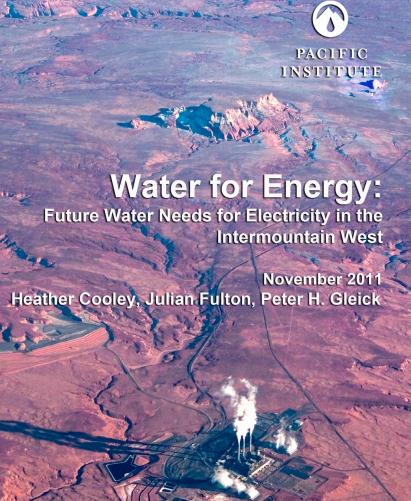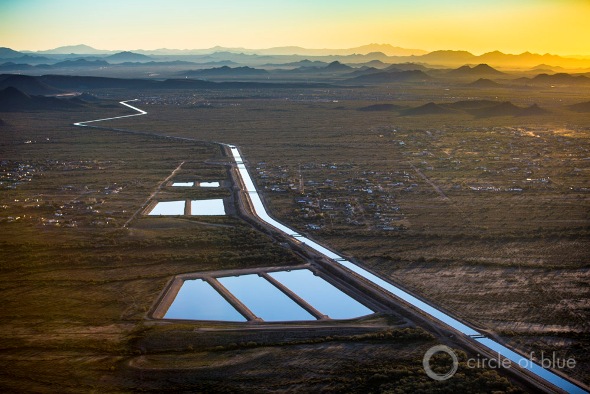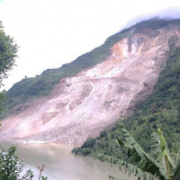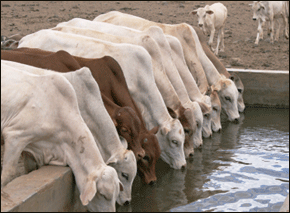Pacific Institute Report: Setbacks and Solutions of Water-Energy Clash in U.S. Intermountain West
At the forefront of a national trend, this region is already suffering from intense conflicts that will only worsen with climate change and population growth. However, the report also highlights several ways to dramatically reduce the water requirements for electricity generation.
Water scarcity is disrupting energy production in the U.S. Intermountain West, even in areas that do not traditionally suffer from water-supply shortages, according to a new report by the Pacific Institute.

To a great extent, the study’s warning is emblematic of the critical water-energy conflicts that are emerging in the United States as a whole, as Circle of Blue has been reporting since last July.
According to the new Pacific Institute report — which published on November 3 — the region where this confrontation is increasing most dramatically is the Intermountain West, bounded by the Rocky Mountains to the east and the Sierra Nevada and Cascade Mountains to the west. The report looks at the water implications of electricity production, but it does not analyze the role of transportation fuels.
A foreshadowing trend is that the region’s intense water-energy conflicts are likely to worsen as climate change and population growth drive up energy use and, subsequently, water demand, which will be compounded by reduced water supplies. Climate change is steadily diminishing snowmelt in the Rocky Mountains and reducing the flow in the Columbia and Colorado river basins. Furthermore, with the population in the 10-state region projected to grow by roughly 33 percent by 2030, the clock is ticking to rein in the pressure on limited water resources and on the demand for electricity.
However, the report also highlights several ways to dramatically reduce the water requirements for electricity generation.
Problems and Solutions
Under current trends, nearly all scenarios project that water consumption within the Rocky Mountain region will increase by 40 percent or more by 2035 and that electricity generation will grow by 20 percent. Meanwhile, water withdrawals and consumption to produce electricity will increase by 2 percent and 5 percent, respectively.
The report predicts that taming these water-energy conflicts will test regional economies, environments, policies, and technological developments. At every stage of energy production — mining, processing, conversion, transportation, and use — the competition for water is becoming more fierce, more complex, and much more difficult to resolve.
— Heather Cooley
Pacific Institute
Water Program Co-director
Last year, for example, a severe drought in the Colorado River Basin reduced the water in Lake Mead, one of the largest reservoirs in the country, to levels that had not been seen since 1956, which prompted the U.S. Bureau of Reclamation to reduce the Hoover Dam’s generating capacity by 23 percent.
“There is an increasing number of proposed power plants that were not built because of concerns of the long-term availability of water,” said Heather Cooley, co-director of the Pacific Institute’s Water Program and the lead author of the new report, in an interview with Circle of Blue “That has impacted a range of power plants, from coal-fired power plants to even solar-thermal plants that have been proposed.”
In 2010, the Arizona Corporation Commission ruled that a 340-megawatt solar plant in Mohave County would have to use dry-cooling technology or treated wastewater in order to meet environmental requirements. This decision responded to public concerns that the facility would require 2.96 million cubic meters (2,400 acre-feet, or 782 million gallons) of groundwater annually from the Hualapai Valley Aquifer in dry Arizona.
“We now know that there are very important links between water and energy and that long-term sustainable use of both resources requires more comprehensive and integrated study and management,” Cooley said. “But this analysis shows the Western U.S. can meet the electricity demands of a growing population using far less water than we do today.”
The study identifies specific steps to reduce the risks associated with the water-energy nexus. By installing dry-cooling systems, deploying renewable energy technologies such as solar photovoltaics and wind turbines, and accelerating water- and energy-efficiency improvements, the amount of water withdrawn and consumed can both be dramatically reduced. Varying scenarios suggest that water withdrawals could drop between 30 percent and 70 percent. Likewise, water consumption could decrease between 20 percent and 45 percent.
Policy Pitfalls
Despite advances that could be made, the report alleges that federal policies are being developed with very little understanding of the water-energy choke points. In particular, the federal government, through subsidies for corn production, has massively increased the production of ethanol, with little concern for the consequences on water supply and water quality.
Similarly, efforts to promote “clean” coal have ignored the water intensity of carbon-capturing technology, which increases water consumption 40 percent to 90 percent, according to the U.S. Department of Energy. Conversely, many water managers are pursuing alternative water-supply options such as desalination, which requires enormous amounts of energy.
“Water and energy are typically managed separately,” Cooley explained. “Unfortunately, water and energy managers have operated as if the other resource is going to be cheap. That, of course, is beginning to change, and, as a result, water and energy managers are becoming increasingly aware of one another.”
, a Bulgaria native, is a Chicago-based reporter for Circle of Blue. She co-writes The Stream, a daily digest of international water news trends.
Interests: Europe, China, Environmental Policy, International Security.









Leave a Reply
Want to join the discussion?Feel free to contribute!